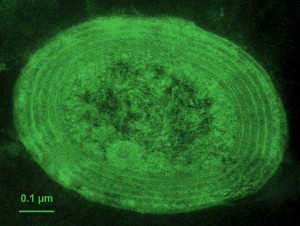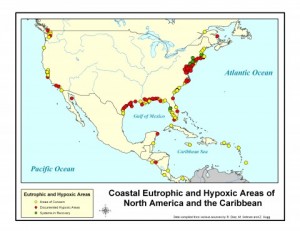
 The Great Big Blue looks like it contains nothing but water and maybe a little salt, especially out in the open ocean. However, this kind of sparse environment is exactly where the chemistry matters the most – it’s a fine line between not enough, too much, and just right. Given this, there’s no distinct myth here but an underlying unresolved question: what is the limiting factor that keeps the open ocean at low productivity?
The Great Big Blue looks like it contains nothing but water and maybe a little salt, especially out in the open ocean. However, this kind of sparse environment is exactly where the chemistry matters the most – it’s a fine line between not enough, too much, and just right. Given this, there’s no distinct myth here but an underlying unresolved question: what is the limiting factor that keeps the open ocean at low productivity?

First, productivity refers to the amount of energy produced by phytoplankton, largely the genus Prochlorococcus. Energy produced by these primary producers travels up the food chain to support the ocean’s largest predators such as tuna, shark, and humans. In addition, these little photosynthesizers produce as much as 90% of the oxygen on Earth, converted from carbon dioxide. Understanding controls over productivity has huge implications not just within the academic community but also for fisheries management and geoengineering schemes for climate change.
A 1988 review by Hecky and Kilham concluded that while the verdict was in for lakes and rivers that phosphorus was the critical limitation, the picture became less clear moving through estuaries and out to sea. They suggested that marine water might be nitrogen limited based on previous theoretical work. Some of this work was summarized in a 1988 book chapter by Bob Howarth, who described three reasons you might expect estuarine and marine waters to be nitrogen limited:
– ratio of N:P in external inputs (farm and detergent runoff, this is changing)
– denitrification by photic zone microbes and sedimentation in plankton fecal matter
– extent to which deficit is made up by nitrogen fixation
Here’s where the pollution factor comes in: in 1988, Howarth estimated that some estuaries were receiving external nutrient inputs roughly 1000 times that of heavily fertilized corn fields. In lake systems, the productivity was directly corrolated to the amount of phosphorus inputs, supporting the idea that lakes are phosphorus limited. And back in the 1980’s, much of that phosphorus was running out of our houses from washing machines and bathtubs from phosphorus-based detergents. This particular source of pollution is still an issue, but far less of one as many companies now use a more eco-friendly formula.
 Arguably, many estuaries have too many nutrients, causing eutrophication and large dead zones due to consequent hypoxia. Howarth also documented that the limiting nutrient in the Chesapeake was season-dependent according to fertilization seasons on farms – when nitrogen runoff was present, phosphorus was limiting and vice versa in the winter. Later studies like those by Cloern in 1999 documented winter light limitation, when nutrients are stored in the system until the following growing season.
Arguably, many estuaries have too many nutrients, causing eutrophication and large dead zones due to consequent hypoxia. Howarth also documented that the limiting nutrient in the Chesapeake was season-dependent according to fertilization seasons on farms – when nitrogen runoff was present, phosphorus was limiting and vice versa in the winter. Later studies like those by Cloern in 1999 documented winter light limitation, when nutrients are stored in the system until the following growing season.
Production in lakes and estuaries is then arguably driven by human activity, but what about the open ocean, where there are few people? In the naturally phytoplankton-poor areas, the consensus seems to be iron limitation (Behrenfeld et al 1996). Phytoplankton were observed to increase both in growth and in individual photosynthetic rates upon addition of iron in culture. However, there is concern over atmospheric deposition of nitrogen even in a system limited by something else. Fanning found that areas in which industrial nitrogen pollution settles out over the ocean tend to be phosphorus limited, suggesting that nitrogen inputs are indeed changing open ocean biochemistry, suggesting that, as with most things ecological, the picture is more complex than originally thought.
~Bluegrass Blue Crab
Literature Cited
HECKY, R., & KILHAM, P. (1988). Nutrient limitation of phytoplankton in freshwater and marine environments: A review of recent evidence on the effects of enrichment Limnology and Oceanography, 33 (4_part_2), 796-822 DOI: 10.4319/lo.1988.33.4_part_2.0796
Howarth, R. (1988). Nutrient Limitation of Net Primary Production in Marine Ecosystems Annual Review of Ecology and Systematics, 19 (1), 89-110 DOI: 10.1146/annurev.es.19.110188.000513
Behrenfeld, M., Bale, A., Kolber, Z., Aiken, J., & Falkowski, P. (1996). Confirmation of iron limitation of phytoplankton photosynthesis in the equatorial Pacific Ocean Nature, 383 (6600), 508-511 DOI: 10.1038/383508a0
Fanning, K. (1989). Influence of atmospheric pollution on nutrient limitation in the
ocean Nature, 339 (6224), 460-463 DOI: 10.1038/339460a0
this is interesting stuff, thanks for posting it. I’m really enjoying the ‘Chemistry of the Great Big Blue’ series. They’re just the right level of detail, and a good length for someone like me to follow. Thanks!